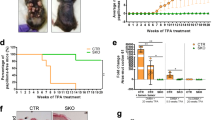Abstract
THE carcinogenic azodye 3′-methyl,4-dimethyl aminoazobenzene induces gross tumours in livers of rats fed a basal diet poor in riboflavin1. The whole process, in Sprague–Dawley rats, takes approximately 200 days. Structural damage to liver tissue may be detected histologically during the first weeks of carcinogen feeding2. Intracellular changes, manifested by the gradual depletion of mitochondria and ergastoplasm, which result in respiratory damage to the cell, can be detected by differential centrifugation weeks and even months before onset of malignancy3; yet all these changes are long-range effects. Even though the continual administration of this carcinogen brings about respiratory damage to the cell, the carcinogen is not a respiratory inhibitor4,5. It can be shown that the specific respiratory activity (activity per mgm. protein nitrogen) with sodium pyruvate as substrate remains normal for mitochondria during feeding with this carcinogen although the tissue is full of protein-bound azodye5. In short, the immediate chemical effect of this carcinogen, apart from its binding to one or more proteins not yet functionally characterized6, is still obscure.
This is a preview of subscription content, access via your institution
Access options
Subscribe to this journal
Receive 51 print issues and online access
$199.00 per year
only $3.90 per issue
Buy this article
- Purchase on Springer Link
- Instant access to full article PDF
Prices may be subject to local taxes which are calculated during checkout
Similar content being viewed by others
References
Wolf, G., “Chemical Induction of Cancer” (Harvard Univ. Press, Cambridge, Mass., 1952).
Conference on Experimental Hepatomas, J. Nat. Cancer Inst., Supp., 15, 1417 (1955).
Fiala, S., Naturwiss., 45, 369 (1958).
Fiala, S., Fiala, A. E., and Sproul, E. E., Proc. Amer. Assoc. Cancer Res., 2, 200 (1957).
Fiala, S., and Fiala, A. E., Brit. J. Cancer, 13 (March 1959).
Miller, E. C., and Miller, J. A., Cancer Res., 7, 468 (1947).
Knox, W. E., Brit. J. Exp. Path., 32, 462 (1951).
Lee, N. D., and Williams, R. H., Biochim. Biophys. Acta, 9, 698 (1952).
Claudatus, J., and Ginori, S., Science, 125, 394 (1957).
Knox, W. E., in “Methods in Enzymology”, edit. by Colowick, S. P. and Kaplan, N. O., 2, 292 (Academic Press, New York, 1953).
Schneider, W. C., J. Biol. Chem., 161, 153 (1945).
Vendrely, R., in “Nucleic Acids”, edit. by Chargaff, E., and Davidson, J. N., 2, 155 (Academic Press, New York, 1955).
Author information
Authors and Affiliations
Rights and permissions
About this article
Cite this article
FIALA, S., FIALA, A. Prevention of Adaptive Formation of Tryptophan Peroxidase by a Carcinogenic Azo Dye. Nature 183, 1532–1533 (1959). https://doi.org/10.1038/1831532a0
Issue Date:
DOI: https://doi.org/10.1038/1831532a0
This article is cited by
Comments
By submitting a comment you agree to abide by our Terms and Community Guidelines. If you find something abusive or that does not comply with our terms or guidelines please flag it as inappropriate.



